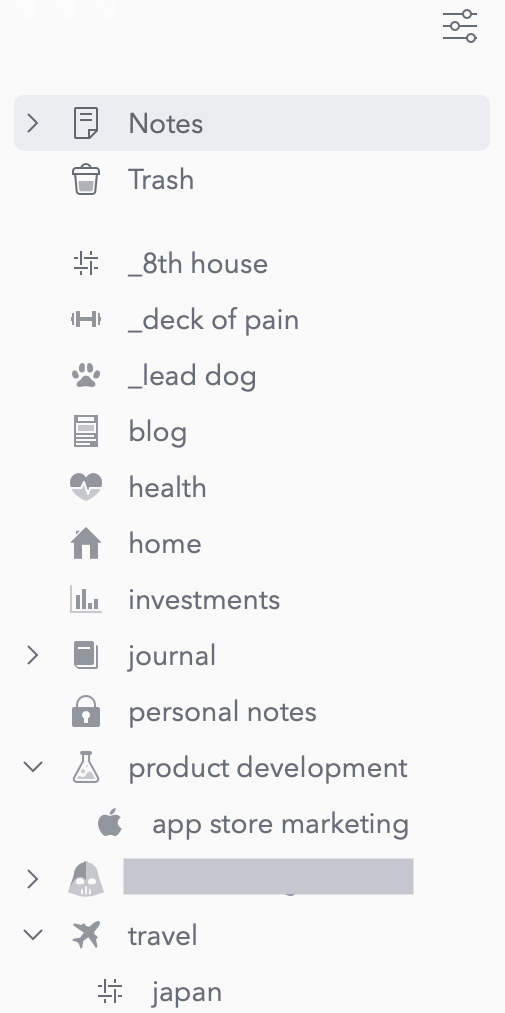My Workflow: Revisited
My workflow, appropriately enough, is the flow of information from one tool to the next. The central tenets of this system are:
Collect → Organize → Action
The tools in each of these steps may vary based on the type of work I’m performing. Starting with a collection of ideas and pushing them through the system into actionable outcomes. Designed over the course of many years, this workflow is a combobulation of Getting Things Done, PARA, and Zettlekasten. ymmv
Collect
All collection happens in the Bear Notes app. Described as a fleeting note in Zettlekasten or the inbox in GTD. Every idea, thought, link, random pieces of data, enter the workflow as a new note in Bear, untagged.
Bear app natively supports an @untagged filter that I use during my daily review at the end of each day to process the notes.
Organize
Processing these notes daily is a crucial step in the workflow, decisions MUST be made; notes that no longer seem interesting are deleted.
Any actionable item that take under 2 minutes is performed immediately in the ways of GTD.
Tasks, links, and time-sensitive items are pushed to the Microsoft To-Do app (more on this in the Action section below).
The Zettlekasten Method
Notes with ideas and thoughts are elaborated on and linked to other notes.
- Information is spread across many interconnected notes.
- Linking related ideas form the hierarchy rather than categorizing notes by topic.
- Notes are organized based on how you might use them in the future.
If you're doing the Zettelkasten Method right, it should resemble a wiki. It's easy for me to get lost in the process, but every now and then, I'll look at the notes and ask myself if it still looks like my personal wikipedia.
This is NOT, however, a "set it and forget it" system. Every time a new note is added, you must follow through with the curation; adding links to related notes, including references to source information, etc.
Goals, Projects, Tasks
The raison d’être of all these notes.
- Goals are high level themes in my life. Never ending pursuits.
- Projects contain a series of tasks linked to a goal with a deadline.
- Tasks are actionable steps that can be finished.
Tags
 The top level tags provide a structure for projects and goals and are visually better thought of as notebooks. The nested tags are entry points to areas of interests.
The top level tags provide a structure for projects and goals and are visually better thought of as notebooks. The nested tags are entry points to areas of interests.
The tags starting with an underscore (so they are sorted at the top, alphabetically) are my notebooks for apps I work on. The Deck of Pain app, has 11 projects and their notes are collectively tagged with _deck of pain.
The remaining tags are notebooks related to themes in my life.
My Travel notebook, contains notes related to places I want to travel or articles about traveling. Actually traveling to Japan will become a project with actionable tasks like booking flight, accommodations, etc.
Action
Tasks are an atomic unit of work, isolated, with a clear definition of done. Crossing off tasks help track progress, create momentum, and maintain motivation in the project.
All my tasks are in context specific apps, best suited to track and complete them.
Microsoft To-Do
Tasks here are grouped by context borrowed from GTD. My post on Microsoft To-Do describes how I use it to focus on tasks for the context or frame of mind I’m in.
In addition to grouping them by context, there is also a transitory list called My Day. It’s a great way for me to see a focused list of the most important action items for that day.
I start each day here.
Linear
Issue tracking for software development. I wrote about how I use Linear to manage my software projects. Issues in Linear adhere to the same rules as the tasks in the To-Do app. All of my development work is in Github and Linear provides an automated way to link the tasks to the codebase.
MindNode
Sometimes the collection of notes in a project can be difficult to visualize as a coherent concept. This happens to me most with writing projects, where I have a lot of related things to talk about, but can’t easily flow from one idea to the next. Mind mapping helps provide a structure/outline for the concept and guides me understanding the next steps. My post on MindNode has an example of how I drafted that very post in MindNode first.
Books, Movies, Podcasts
I used to have a note with a running list of books I’d like to read or movies I’d like to watch. It didn’t fit the system. Content that is recommended or that I find interesting are added directly to these respective apps:
- Kindle (books)
- Letterboxd (movies)
- Castro (podcasts)
I prioritize, consume, and these apps automatically log or archive them. Maintaining a complete history without cluttering my workflow. Highlights from books or show notes from podcasts are often collected in the workflow and lead to new projects or further reading.
Final thought
This workflow helps me be and stay productive. When the process works, I find myself looking forward to the next day, energized and ready to tackle the projects at hand.